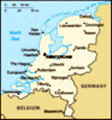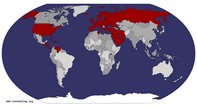Advertisement
Published: June 26th 2016
When in Haarlem we had an opportunity to meet and talk with a Dutch couple who were heading out at the same time we were in the direction of Gouda (the “Gou" is pronounced like the word “how”). He told us that we should stop at a museum that was right on the canal. He explained it was an old pumping system that had been converted into a museum. He also explained that it was one of the great engineering feats of the 19th century. This worked well into our schedule because there was a highway bridge that had a very restrictive opening time farther down the line so we had a few extra hours. Less than an hour of travel time in the canal we came upon the museum, you can't miss it – it looks like a small castle with an eight legged spider climbing out of it! Fortunately there was a dock nearby so it made for an easy stop to visit the Cruquius Museum.
A little background information might be helpful at this point. What most people don't understand is that over 14 percent of the Netherlands territory is in fact under sea level. Since the
beginning of time the Dutch have been building dikes and turning sea bottom into agricultural land. The problem is twofold, number one you build a dike to keep the ocean out; more complicated than it sounds and extremely labor-intensive. The second part of your problem is water draining off the highlands in Germany and flowing into the Delta which is Holland. So not only do you have to keep the sea out, but you have to get rid of the water flowing in from the rivers of Germany. To make this problem worse, the Dutch were digging up the marshes extracting large amounts of peat to use for heating and cooking. As the guide said, the Dutch love nothing better than something that is free! By digging the peat out, they made the lakes larger almost double in size. Oh, and let's not forget this part of the world also gets a lot of rain. So for hundreds of years the Dutch have been engineering their way out of this problem. When flooding occurred these large lakes they had increased in size overflowed their banks and flooded out the residential areas nearby.
Most everyone who thinks of Holland thinks
of windmills. Windmills were one of the first engineering solutions to pumping water out of the low lands behind the dikes. One windmill is capable of lifting water about 3 feet (approximately 1 meter) driving a device called an Archimedes screw; the bigger the windmill the more water you can pump but only 3 foot. Now you might ask yourself why only 3 feet, I could explain that but it would involve discussions of gravity and the molecular structure of a water molecule and as a good friend of mine would say “too much detail”. The Archimedes screw has been used to move water up into irrigation all the way back to the time of the Egyptians and before. The Dutch used the windmill as the power source for the Archimedes screw to pump water out from behind the dike. The problem is in many areas water needed to be pumped 15 to 20 feet in order to drain the land. This would mean a minimum of 5 windmills placed in series. For a land with little timber and almost no stone building material, windmills were an expensive and time-consuming process. It also was dependent on the wind which you
could not always count on. Controlling water is not just about agricultural land, but about controlling flooding in cities and towns. After a number of very serious floods in Amsterdam, King William I appointed a royal commission of inquiry (1837) to figure out how to solve the problem. By the mid-1800s a new power source had been developed, the steam engines. In1847 the Dutch working closely with the English built three pumping stations similar to the one we were visiting. These pumps were driven by the world’s largest steam engine and were capable of lifting 55,000 gallons of water 15 feet in a minute. This meant that the Dutch were able to build an extremely large canal enclosing more than 72 mi.² lake south of Amsterdam. With the use of 3 of these steam driven pumping stations they were able to pump the land dry in 3 years. Each pumping station had one steam engine fired by six large coal-fired boilers that powered a RAM that lifted eight arms ( each weighing over 10,000 pounds), each arm connected to one pumping cylinder. I could continue to bore you with the statistics but take my word for it this thing is
amazing. In most of the world canals were used for transportation or irrigation; in Holland they serve both purposes. In this case they built a canal around the lake that was higher than sea level, then they used the steam driven pumps to pump the water out of the lake and into the canals which then would carry the water to the rivers and out to sea. These pumps continued to work until 1935 when they were replaced by numerous smaller diesel powered pumps. Fortunately this one was refurbished and with the installation of a hydraulic pump the museum was opened and is able to educate us to this complex and fascinating process of how the Netherlands has worked over the years and continues to keep their land dry and an excellent agricultural area. The Netherlands is a very densely populated country. Only Bangladesh, South Korea, and Taiwan have a higher population density; however the Netherlands is the world's second largest exporter of food and agricultural products after the United States. We knew that we have seen many agricultural fields, but were very surprised by this statistic.
After our visit to the Cruquius Museum we continued on toward Gouda
and thankfully in plenty of time for the bridge just prior to entering Gouda that only had a couple of openings per day. We decided to try a marina that we did not have to go through any more locks or bridges to get to – we had called ahead and they said they had room for us. It is a little off the main canal, but found it without a problem. The most difficult part of coming here was that the channel kept getting narrower and narrower with less and less water. Fortunately the captain was able to turn the boat around and we secured a side tie next to a dock. The great thing about this move was that we were headed out in the right direction when we left. The people at the marina were very friendly and helpful. We found it was a small yacht club that welcomed visitors. They provided us with a map and with that in hand we headed out to do a little exploration.
You may recognize the name Gouda if you have tried any of the cheese of the same name. It is definitely one of the big selling items
here in town. At the main square there was a farmer’s market going on so of course checked it out and bought a few items including that wonderful Gouda cheese. They offer it in numerous flavors so we bought a few to try out. One building that is very conspicuous in the square is one with red shutters. We found it was the Town Hall which we would have liked to tour, but unfortunately they were having official meetings and we never did make it in to see the interior which we heard was quite remarkable. The reason this building is a stand-alone building was that back in 1438 there was a major fire that destroyed the then town of Gouda. The town council decided that in rebuilding the town hall they would separate it from any of its neighbors to hopefully avoid this same fate in the future. It definitely makes an impressive statement standing majestically by itself.
Another easily identifiable building at the main square is the Weighing House by the carvings on the face of the building. This now holds the Cheese Museum and the Visitor Center so did make it in to the interior where

 The Water is Pumped UP from this Canal
The Water is Pumped UP from this Canal
to keep the land drained (land is lower than canal)they had on display how the cheese had been weighed in the past. Unfortunately we did not make it here on a Thursday as they have a “show” of how the cheese had been weighed in the past. We know they do this in numerous towns throughout the region and have heard it is quite interesting to see.
We thought we were only going to stay in Gouda one night so we made the decision to see the Sint-Janskerk. It is reputed to be the longest church in the Netherlands as it is 123 meters long. It was hard to tell as it is closely surrounded by other buildings, but we did finally get a view that could show us its size. The stained glass windows are known at the Gouda Windows and have quite a history. The 72 stained glass windows were mainly made in the 16
th century. They depicted Biblical and historical events in their designs. Many were funded by wealthy clergy and nobles; therefore in return their images were a prominent feature in the lower 1/3
rd of the window. The church began in 1280 as a Roman Catholic Church and stayed that way until the Reformation
of 1572. Fortunately the town council released the importance of the windows and took steps to save them. Then again just before WWII broke out, they went to great pains to take the stained glass windows apart and box them up in crates and hid them so they would not be damaged. We are fortunate today to be able to view these windows due to their foresight and care. The church has audio tapes in English that were excellent in describing the windows and telling more about the history of the times in which they were installed. From the outside of the building the windows appear to be quite dark, but part of this is due to the metal protection installed on the outside so they are protected from damage.
The 2
nd day when we had originally planned to leave we woke up to heavy rains. We can definitely move in the rain, but … even though we know we have a deadline of June 30
th to be in the Channel Islands, we decided that one more day would not cause us a problem. We took that extra time to do a few things on the boat and then
took a short walk toward town. The sky opened up and we quickly looked like drowned rats so decided to turn around and head back to the boat. Fortunately we dried out and took a shorter walk near the marina. Bob was very happy to have found a DIY very close by so he got his “fix” for a little time. We continued on and walked a few paths nearby and then called it a day as we were moving again in the morning.
Gouda has much more to offer to those that visit, but it is now time to push on and bypass some of the “things you can do” when visiting a town or village. Even with cutting the time short, we enjoyed our stopover in Gouda.
Advertisement
Tot: 0.127s; Tpl: 0.012s; cc: 11; qc: 31; dbt: 0.0643s; 1; m:domysql w:travelblog (10.17.0.13); sld: 1;
; mem: 1.2mb























